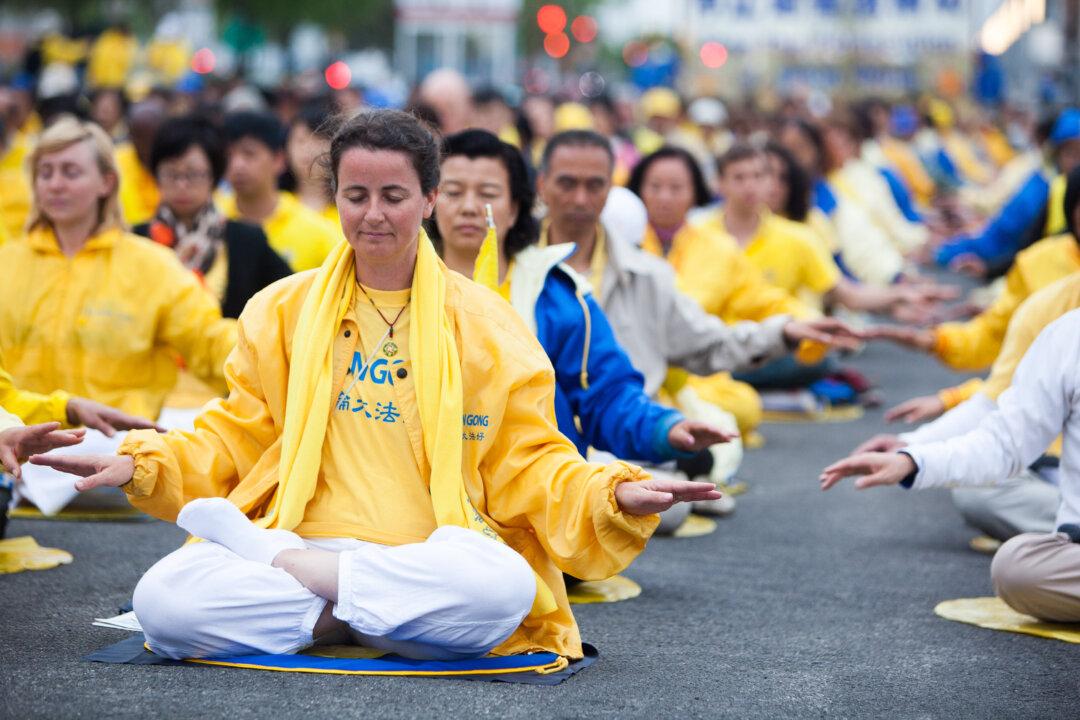NEW YORK—With the deafening air horns from the Hudson River and the West Side Highway, the Hudson River Greenway is among the least convenient sites for meditation. Yet hundreds gathered there on Wednesday evening, meditating, unmoved, for their fellow people.
The place where they meditated is right across the street from the Chinese Consulate. The meditators practice Falun Dafa, a spiritual discipline persecuted in China. With the majority of the meditators being Chinese, it wasn’t hard to find one who experienced the persecution firsthand.
Practicing Falun Dafa
Lili Chen grew up in Shenyang, a city of five million in southern China. Being raised atheist, the spiritual ways of her ancestors sounded magical and unbelievable to her. Still, with her colleague’s recommendation, she picked up “Zhuan Falun,” the main text of Falun Dafa, in 1997.
Falun Dafa (or Falun Gong) is a system of five slow-motion exercises and a way of living based on the principles of truthfulness, compassion, and tolerance. Such principles, permeating the many Chinese traditional beliefs, were hardly heard of after the ferocious suppression of traditional values during the Cultural Revolution in the 1960s.
Yet, the opening of the country to foreign capital in the late 70s signified a failure of communist beliefs for many, adding to a spiritual vacuum many later attributed to the rapid growth of Falun Dafa.
Chen started to visit a practice site in her city and was surprised to hear almost everyone there had a story of miraculous health improvement. “There were a lot of elderly people,” she said through a translator. One senior lady, Chen remembered, was able to heal her legs through the practice and didn’t need to use a walker anymore. Chen found the practice quite unusual, and gradually gained confidence in it.
People who practice the Falun Dafa exercises and follow the principles refer to themselves as “practitioners,” a translation of the Chinese “xueyuan.” There were as many as 100 million in China, according to a 1998 government survey. The practice enjoyed endorsements in the state-run media and the government saw it as a way to save on heath care costs, as it was spread free of charge.
The Persecution
But the situation was about to change. Several people at the top of the ruling Communist Party felt threatened by the growing popularity of Falun Gong, especially then-party leader Jiang Zemin.
In July 20, 1999, Jiang ordered Falun Gong to be “eradicated,” launching a massive defamation and repression campaign many believed furthered his personal agenda.
“By unleashing a Mao-style movement, Jiang is forcing senior cadres to pledge allegiance to his line,” stated the CNN, quoting an unidentified party veteran in 2001. “This will boost Jiang’s authority—and may give him enough momentum to enable him to dictate events at the pivotal 16th Communist Party congress next year.”
While in the end the persecution brought Jiang nothing but dozens of lawsuits for genocide around the world, it imposed enormous suffering on millions.
When Chen heard in the news that Falun Gong was banned, she was confused. All the media incessantly repeated that Falun Gong is “dangerous” and “evil,” but her personal experience was quite the opposite.
In the end, she and several other practitioners from her area figured maybe the top leadership didn’t understand what Falun Gong is. They wrote a letter describing their experiences and sent it the party leadership.
All who signed the letter were arrested within months. Chen was held for 15 days and then released, but kept under surveillance.
Torture
In 2001, Chen was arrested again for producing materials about Falun Gong and the persecution. She was taken to a detention center to await her sentence. She went on a hunger strike to protest. The police responded by force-feeding her. A thick rubber tube would be forced up a nostril and down to the stomach. Sometimes they poured in rice porridge, but more often than not it was irritating substances like salt or chillies. Even cases of force-feeding with feces were reported. As such, this torture method is reported as the most common cause of death of incarcerated Falun Gong practitioners.
Chen was force-fed every three days. The tube would be bloody when taken out, she remembered.
After a year in the detention center, she was sentenced to three years in prison. But due to her health condition, she was released instead—thin to the bone and unable to walk. At that time police were still afraid to be responsible for Falun Gong practitioners dying in custody. Later an order came from the party leadership to report practitioners tortured to death as suicides.
The overseas Falun Gong website Minghui.net documents almost 90,000 accounts of torture in custody and almost 3,500 deaths related to the persecution. The actual number is estimated to be many times higher.
Living in Fear
Since her release, Chen’s family lived in constant fear. Her husband would be very worried every time she was late from work. One time, Chen remembered, her husband got “scared to death” when they were separated during shopping, even though she was just in another store nearby.
She learned to be careful. The police came to her house many times, but never found a pretext to arrest her again.
Escape
In April 2014, right before the anniversary of the first Falun Gong appeal to the central government, many practitioners were arrested in Shenyang—a common occurrence around the so-called “sensitive dates.” This time Chen decided it’s time for her to leave. On May 9 she boarded a flight overseas and applied for refugee status in Canada.
From her look and demeanor, walking down West 42nd Street, chatting with friends, hardly anyone would guess what she has been through.





